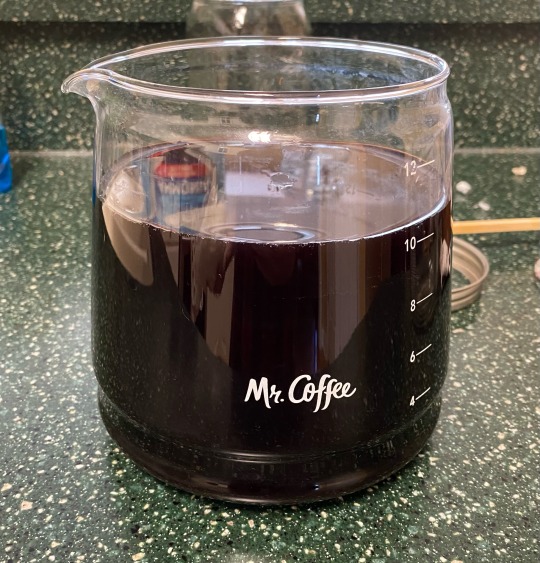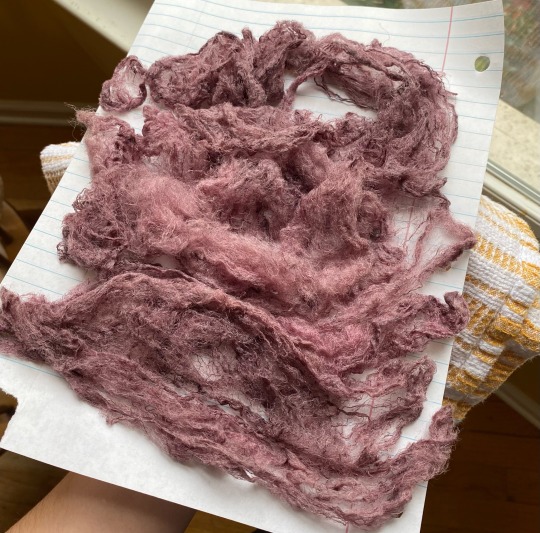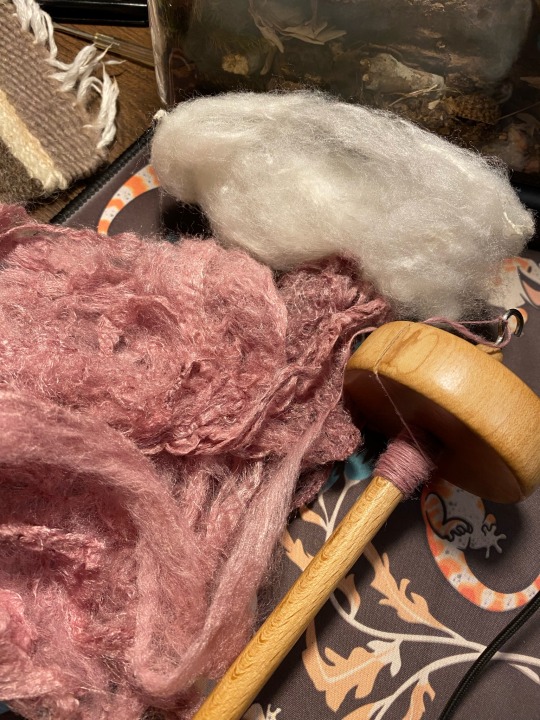#orcinol
Text
Alrighty so this is the post on lichen dyes!
this particular bath of lichen dyes was originally started over a year ago scraping a tentatively-ID'd lecanora and/or ochrolechia genus lichen off of a fallen branch (remember, don't gather lichen when it's still growing! it's very slow growing and easy to overharvest)
to start off, this particular type of dye is made through the ammonia-fermentation method, also known as ammonia maceration. No actual bacterial fermentation occurs though. Rather, the compound orcinol (and precursor compound to orcinols) react with ammonia (N2) and oxygen to form the compound orcein (also called orchil/archil) which is what makes the final dye!
this process takes anywhere from 3 weeks to 16+ weeks depending on the lichen species, its constituent acids, the temperature, and the frequency of aeration.

This batch was set aside for several months and neglected a good bit, but it still works. I strained out the crumbled lichens (which i set aside for later) and diluted it 1:4 as instructed by a very good book called Lichen Dyes: The New Source Book by Karen Diadick Casselman. This book is basically omnipresent everywhere you see lichen dyes mentioned, especially the orcein-based dyes. I also used several websites/videos/papers and such that i've hunted down over various internet crawls.
I use an old coffee pot for this as it's both a non-reactive material (glass) and is built to withstand heat. Ironically i also scraped the lichens off the branch using a tool i made out of a metal band from the broken handle of this same coffee pot!

I decided to dye some eri silk cakes that i fluffed up and scoured. these have been very good at absorbing dye in the past so i would hopefully get a good result from them. As lichens are a substantive dye i don't have to put a mordant on them, but i did soak them in an alum solution just before adding them to the dye bath to hopefully maximize dye uptake as well as improve fastness as lichen dyes are also fugitive and can fade in sunlight.
Substantive dyes contain mordants already embedded in them; fugitive dyes are a bit fuzzy to me but my understanding is they end up trapped in the fiber instead of actually bonding to the fiber in a stronger way. Mordants are used to help the dye "bite" onto the fiber better, improving both fastness (the ability of a due to resist fading from sunlight/washing/time) and the brightness of a color. Alum is useful in that it typically doesn't affect the end color of a dye more than simply making it slightly more strong!

it was pretty successful i'd say! i warmed up the dyebath, added the silk, let it simmer for a few hours, let it cool down overnight, and then warmed it back up the next day for a few hours; then, when it cooled, i took it out, let it dry, then rinsed it, and let it dry a second time. At that point, it was ready for spinning!

It was a lovely pink color that's not fully captured by the camera like most dyes, and eri silk is lovely because you can spin the clouds directly and easily without carding and make lovely relatively threadlike yarn

this was the first skein i got! i love how shiny the silk is. Some dyes can get really purple or even magenta-like!
next, i had the leftover lichens that i had set aside. They were a crumbly texture and dark black and i dried them out, crushed them up more, set them back in a jar, added more ammonia and water, and did the ammonia fermentation method a second time! this was after reading about the method for making french purple, and while this is definitely a very pale imitation of the method, the double-soak is the key feature here
here it is (on the left); it was already way darker purple than an in-progress lichen dye i had yet to crack open and use

speaking of which, heres a shot of various test lichens i had while working on this, you can see the blue-capped jar that has the second-soaked lichens. the foam will often give a preview of whether or not the dye will be red/purple or not!

Here it is, i forget how long i let it soak but i think it was a bit over a week. i strained the material out, diluted it, and then repeated the same warm/cool/warm/cool/dry/rinse/dry method with more eri silk

And below you can see the difference, it's definitely slight but still cool!

the left is from the original dyebath, the right is the second-soaked one. the first one is more salmon-colored while the second is a tad more blue-purpled!
I'm extremely excited about this, these dyes have such a fascinating history and have multiple historical uses everywhere from florentine orchil to norwegian korkje to scottish cudbear and more, and it was often used in tandem with the roman murex/tyrian purple dyes that come from a mussel. Some folks used the lichens to pre-dye the fabric before dyeing with tyrian purple, both to stretch the expensive tyrian purple and to make the end color more vibrant. It's all such a great topic that's mightily confusing and could take up a post of its own, same with the underlying chemistry of what makes these dyes work in the first place!
Anyways that's all for this post, i have more i'm working on involving actually turning these dyes into paint that i'll hopefully turn into a post on its own soon! I've also got other lichen dyes I'm waiting to get through the ammonia fermentation process that will hopefully give other colors, whenever that may be!
#lichen dyes#ammonia fermentaion#handspinning#natural dyes#eri silk#yarnmaking#fiber arts#vegetable dyes#orcinol#art#orcein#archil#crafts#yarn#silk#drop spindle
615 notes
·
View notes
Text

i am doing Science
(Evernia sp/british soldier lichen/reindeer lichen/toadskin lichen/secondary processing if lecanora sp/first processing of lecanora sp)
majority collected from fallen sources or by following the less-than-10% rule in plentiful areas (soldier lichen + toadskin lichen). Never overharvest lichens! they grow very slowly
I'm going after archil/orcein dyes derived from the orcinol and orcinol precursor acids. I wanna make a more in-depth post about it on my crafts and shenanigans sideblog soon
4 notes
·
View notes
Text
Literally experiencing slow burn
0 notes
Photo

Orcinol Manufacturer and Exporter
Oxford Lab Fine Chem is a leading Orcinol Manufacturer and Exporter from India. For more details and enquiry please visit www.oxfordlabfinechem.com
0 notes
Photo






Roccella tinctoria
The history of R. tinctoria stretches all the way back to Pliny the Elder--one of my favorite bizarre historical figures who got a lot of information wrong. And in this case, it was by describing R. tinctoria as a plant with “knotted roots” that resembles grass, but I suppose I can forgive him for that one. At least he didn’t prescribe it as a treatment for gout or something, as he was want to do. This fruticose lichen has thin, cylindrical branches which grow in erect bunches from a single holdfast. It is light brown or greenish-brown in coloration, and spotted with farinose sorelia in convex clumps. It grows on costal rock in the Mediterranean and Macronesia. R. tinctoria has historically been used by humans for dying, as it produces a surprising red-purple color from it’s secondary metabolite Orcinol. It is also a main component of litmus--as in “litmus test”--a mixture used as a pH indicator.
images: source | source
info: source | source | source | source
#lichen#lichens#lichenology#lichenologist#lichenized fungus#fungus#fungi#mycology#ecology#biology#history#natural history#biodiversity#systematics#taxonomy#life science#natural science#environmental science#nature#naturalist#beautiful nature#weird nature#look for lichens#Pliny the Elder#cottagecore#naturecore#Roccella#Roccella tinctoria#I love lichens#lichens are so good
37 notes
·
View notes
Photo

Narcissus tazetta (var. Geranium)
Tazetta daffodils are noted for their lovely fragrance but Narcissus tazetta scent contains a compound called ‘orcinol dimethyl ether’ which only honeybees can detect.
#flowers#photographers on tumblr#daffodil#Narcissus tazetta#my garden#fleurs#flores#fiori#blumen#Vancouver
95 notes
·
View notes
Link
0 notes
Text
Xian Mao Curculigo orchioides Gaertn Rhizoma Curculiginis 仙茅

Traditional Chinese herbal info
Festuca arundinacea, also known as ground palm (Sichuan, Guizhou), Festuca arundinacea (Sichuan), Codonopsis pilosula (Fujian), Festuca arundinacea (Yunnan), Hainan ginseng (Hainan), Festuca claw, Brahman ginseng, belongs to Festuca family, flowering from April to September.
Main components: curculigoside A B ,orcinol glucoside, corchioside A ,curculigosaponin A B C D E F K L M, curculigine A B C, curculigenin A B C, curculigol, yuccagenin .etc
Functions and indications:Medicinal plants have the functions of tonifying kidney and Yang, benefiting essence and blood, strengthening muscles and bones, promoting blood circulation and detumescence
Read the full article
0 notes
Text
Orcinol Market Competitive Insights and Forecast Report 2019
Orcinol Market Competitive Insights and Forecast Report 2019
Orcinol Market Insights 2019, Global and Chinese Scenario is a professional and in-depth study on the current state of the global Orcinol Industrywith a focus on the Chinese market. The report provides key statistics on the market status of the Orcinol manufacturers and is a valuable source of guidance and direction for companies and individuals interested in the industry. Overall, the report…
View On WordPress
0 notes
Text
Orcinol
A crystalline compound extracted from certain lichens and used to make dyes.
1 note
·
View note